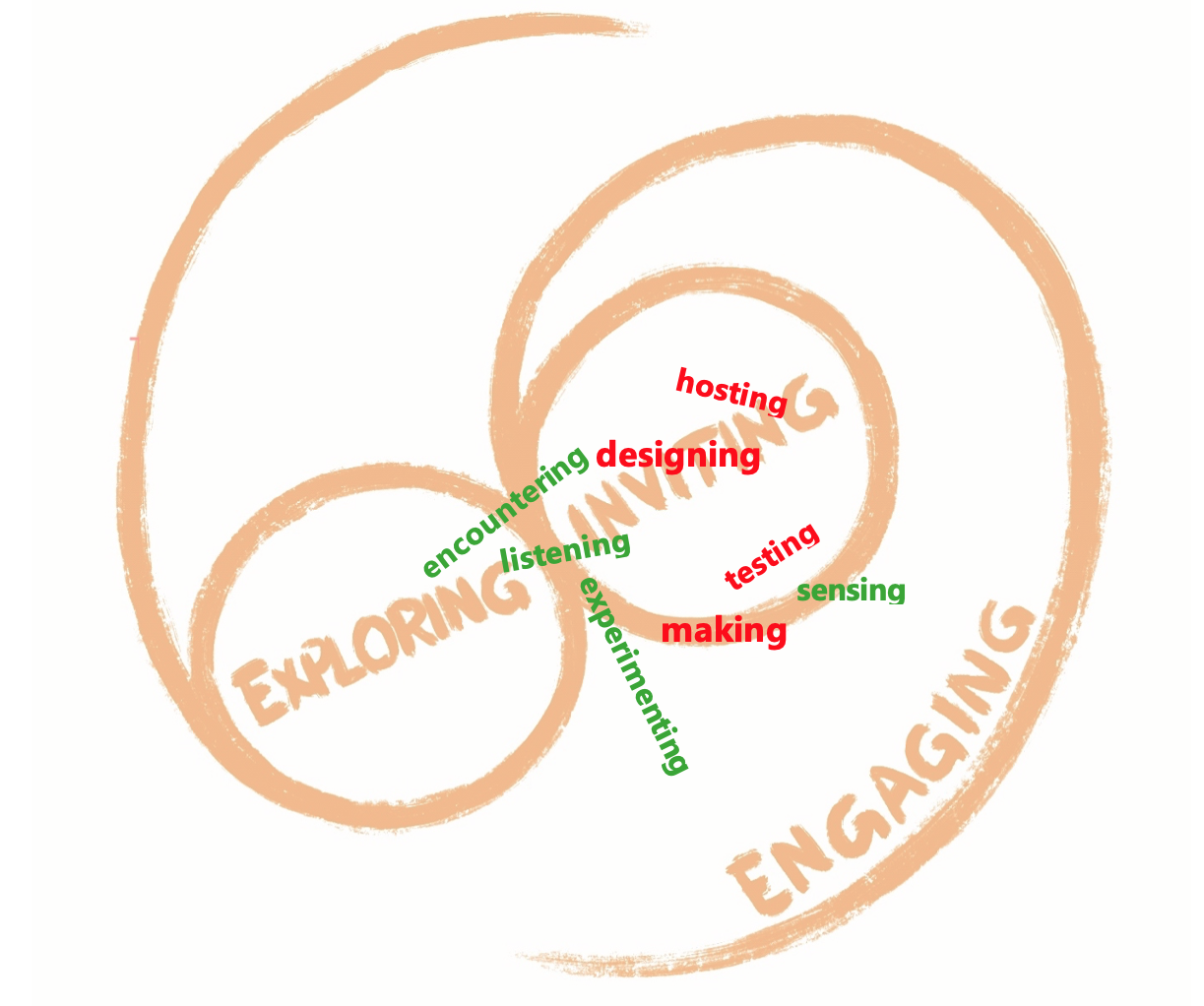Inviting
Description
The second learning movement consists of 5 components: students working in subgroups on establishing a dialogical space (1), designing (2) and testing (3) imaginative dialogues, inviting others to participate (4), meanwhile working on reflective documentation (4) for the duration of this movement.
While students take the theme that had been explored in the former learning movement as a productive starting point, the aim of this ‘inviting’ movement is to make the interesting and uncomfortable differences that they encounter fruitful in artistic ways. By doing so, they might become aware of the act of valuing that will emerge. However, it’s not easy to articulate interesting and uncomfortable differences that really matter in a very precise way. That’s why, instead of just discussing or theorising about these differences, the focus is on lived experiences. For instance, students may be encouraged to share their different experiences of feeling safe or unsafe in a specific situation.
The challenge for the students is how to use art and sensuous approaches to establish a certain common platform for allowing a polyphony of voices to appear.
Teachers are mainly involved at the beginning of this movement; they hand out a proposition to each subgroup of students – preferably in an envelope (see in the example below). Therein, there is concise information about what is meant by a dialogical space, an imaginative dialogue and reflective documentation.
While it is possible to have more teacher-driven exercises that support the creative process of the students, this movement consists primarily of students’ working in their self-chosen small groups, and being engaged in an intense creative process that is highly sensory and embodied.
During their process of designing imaginative dialogues, students regularly invite others to take part in order to ‘test’ their design and gain formative feedback. Those invited can be students from other subgroups but also participants from elsewhere. In the PIMDI project for example, this involved senior centres, an art museum and a boarding school. The approach in each of these places was different; there was an emphasis on ‘movement and touch’ (senior center), ‘visual art and visuality’ (art museum), and ‘sensuous relations to nature/surroundings’ (boarding school).
Students generally report the group work as an interesting and gratifying experience, while noting that the encounter with others ‘from outside’ is very intense and important. This movement is all about inviting others to step into the dialogical space and to take part in dialogues about the given theme in imaginative and embodied ways.
Components and movements

This movement is about the parallel learning of student and teacher, the one who undergoes an experience and the one who designs and instigates an experience for others. Between exploring and inviting, a positioning as an artist-educator takes place, someone who designs a place and frameworks for others to receive new, transformational, experiences.
Examples
Envelope: the proposition (see also concept ‘Proposition’)
Work in your subgroup on the given theme (for example: ‘Safety and Transgression’) by establishing a dialogical space that offers conditions for working in a group and for dialogue to occur. Then, design an imaginative dialogue in which others join.
Develop an imaginative dialogue
- An imaginative dialogue involves the creation of new experiences by artistic means and an exploration of the unexpected.
- In this dialogue, participants notice and question their assumptions and prejudices. The dialogue involves curiosity, play, humour, attentiveness, sensing, silence, listening, relaxation and interest in otherness and the unknown.
- In imaginative dialogues, the language of different art disciplines is spoken; there can be interdisciplinarity (between disciplines) or multimodality (multiple literacies within one medium).
- Experiment with preparatory exercises to wake up your senses before you start your working sessions. Everyone can bring in exercises from their own experience.
- auditive exercises
- embodied exercises
- theatrical or dance exercises
Build a dialogical space
- A dialogical space is both a social & a physical space that has its own ‘rules’, configuration of actors (roles), meanings and relations, thus providing fruitful conditions for imaginative dialogues.
- It involves a conscious and spatial arrangement of all physical and non-physical elements that constitute the dialogue.
- A dialogical space is different from the surrounding space, this means that it has a ‘border’. Entering it involves a threshold experience, thus it needs a ritual that marks the partition of space.
- Explicit ground rules of dialogical space relate to those of ‘brave space’.
Practice Reflective documentation
Integrate reflective documentation in the process. Consider what the documentation does; how it frames and highlights something, and in so doing, what kinds of new thoughts and ideas it may generate. Also, what does it omit? In an imaginative and reflective way, capture and document the process (the way you collaborate), the performative quality of the imaginative dialogue, and the dialogical space (what does it do?)
Learning
Learning is not directed solely at the students. In the process, teachers and students learn together.
Ability
– to design and facilitate imaginative dialogues for different contexts and participants
-to extract relevant differences and explore them in imaginative ways through different art forms
-to create a safe and brave dialogical space together
-to challenge different experiences in a multi-sensory and polyphonic manner, giving way to each personal voice
Arts pedagogical sensitivity:
– to pay attention to own perceptions and those of others
– to be able to register differences in attitude and awareness
– to be able to ‘hold the space’
– to be able to use your own medium/discipline to deepen the dialogue (listen, interact, speak, and create differently).
